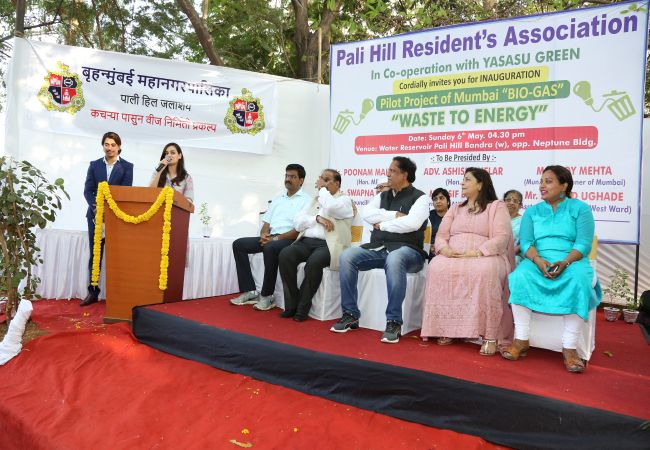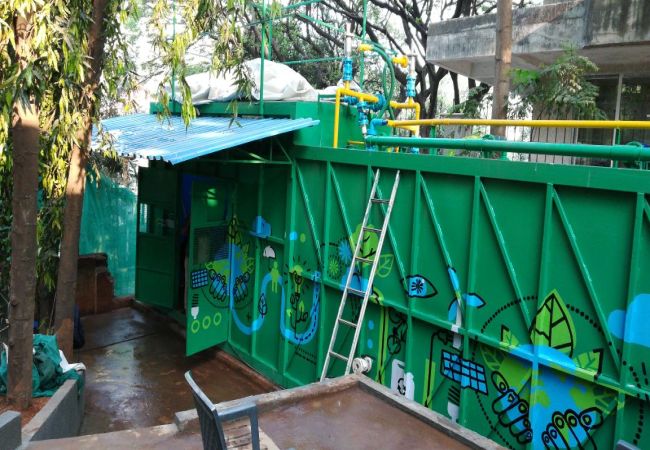Mumbai: As the sun comes down, people residing in one of the Mumbai’s posh areas, Pali Hill, are seen taking strolls, jogging, and taking their dogs out for a walk. Amidst these regular scenes of a relaxed evening what may go unnoticed is the 68 street lights. What is special about these lights is that these are being powered through power being generated from household waste. Yes, the area comprising 78 buildings and 23 bungalows is the first and only area in Mumbai which is converting its wet garbage into electricity.
The waste-to-energy plant was inaugurated in Bandra West by MLA Ashish Shelar along with United Nations Environment’s Goodwill Ambassador for India Dia Mirza on May 6. The project, which is a brainchild of the Pali Hill Residents Association (PHRA), is being carried out in collaboration with the Brihanamumbai Municipal Corporation (BMC) and Organic Recycling Systems Pvt Ltd, a company working in the anaerobic digestion technology space.
It has been a little over three weeks since the plant was inaugurated and so far the project has been working successfully. As anticipated, it lights a total of 68 street lights by producing 100 kilo watts of electricity from 800 -10,000 kilos of waste per day. The plant, spread over 100 square kilometer of the Pali Hill Water Reservoir on Nargis Dutt Road, uses anaerobic digestion (a process in which microorganisms break down biodegradable material in the absence of oxygen) technology to treat the waste and produce biogas. The energy is used to power street lights on one kilometer stretch. The plant is estimated to save the civic body ₹14 lakh per annum in electricity bills and transportation cost of carrying waste to the landfill.
Also Read: Someone’s Waste Is Another’s Music: Dharavi Rocks Creates Magic From Trash
Bandra Waste To Energy Plant: How Did It Start?
Concerned about the overflowing of landfills in Mumbai, the Pali Hill association decided to incorporate the practice of treating waste at source on a daily basis and reducing the burden on the dumping grounds by putting the waste to some productive use.
Most of the residents in Pali Hill were convinced with the idea of treating garbage at source. However, they demanded for one collective unit where the area’s waste could be treated. I approached the BMC and we started looking for options, says Madhu Poplai, secretary of the PHRA.
After researching for nearly eight months a breakthrough was achieved,
The BMC provided the association with a land where the plant could be set up, Organic Recycling Systems Pvt Ltd gave them the plant under their Corporate-Social Responsibility (CSR) and citizens started to practise waste segregation.
Waste To Energy Step 1: Waste Segregation
The most important step was to convince every household to practise waste segregation. A daunting task was to train domestic helps in keeping dry and wet waste separately as majority of the houses have servants who handle the waste.
We knew it would be hard for the association to break away from old habits and thus we resorted to competitions. Weekly competitions were held between domestic helps and BMC sweepers where Rs 2,000 would be given to the person with the most efficient segregation activity, says Ms Poplai
It took less than three weeks for Pali Hill to achieve 100 per cent waste segregation. The segregation not only helped the residents in making the biogas process swift but also brought down the overall waste generation to 800 kilos from the earlier 2,000 kilos per day.
All the organic waste generated by the residents is transported to the plant by BMC safai karamchaaris. The functioning, processing and maintenance of the plant is done by the recycling company.
Step 2: Transportation Of Segregated Waste
The waste is first screened to identify inorganic waste and then fed into the digestor. Once the garbage is shredded it is transported to the digestion chamber where it takes around 20 days to generate the biogas which then produces power, explains Rohit Agarwal, Head of Group Commercial, Organic Recycling Systems Pvt Ltd.
Final Goal: Go Zero Waste
With an aim to ensure zero waste generation, the residue left after producing biogas is used to make manure. Around 200 kilos of manure have been procured from this plant. The PHRA will cultivate plants on two barren lands provided by the BMC. The vegetables will be given to a nearby orphanage and an old-age home. As for the dry waste, it is collected three times in a week by the BMC staff.
Zero Waste Tag Achieved, What Next?
With the practice of waste management now being on track for the residents of Pali Hill, the next battle will be to tackle plastic waste. Ms Poplai has been collecting plastic bottles and polythenes since one month. The accumulated plastic waste is being fed into the crusher machine at the waste-to-energy plant. Every morning, the BMC vans collect the shredded plastic and give it to the local recycling units.
Ms Madhu also plans to produce cloth bags and provide employment to the underprivileged section of the society,
My initiative is at a preliminary stage. I plan on employing 50 women who can stitch cloth bags. I have already got a sponsor for the procurement of a sewing machine. The cloth bags will be distributed among the residents of Pali Hill at a subsidised rate.
The city of Mumbai, on an average, generates 7,700 tonnes of waste daily of which a mere 42 per cent is treated scientifically, either via composting or recycling. The remaining is dumped on the overflowing landfills of Deonar, Kanjurmarg and Mulund, which are way past their life span and a fire and health hazard. Taking into consideration the shrinking spaces of the overly populated city, it may not feasible for every society or locality to set up waste treatment plants like the PRHA, but by practising waste segregation every Mumbaikar can at least help in cutting down city’s overall garbage generation and prevent further burdening its landfills and reduce the risk of frequent fires.
Got A Similar Story? Share The Swachh Story With Us

































